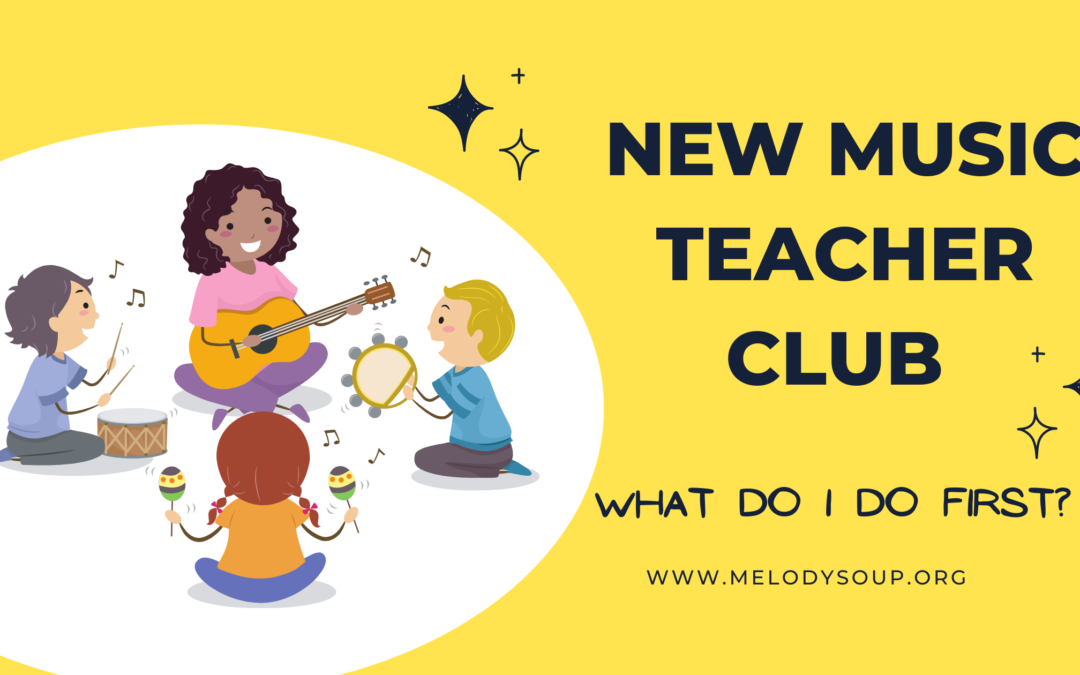Today a younger music teacher who belongs to one of the Facebook teacher groups that I am in who is moving campuses expressed concerns about what to do first when moving to a new campus. Getting started can be overwhelming and so I thought I would reply. What you see below is my response.
1. Set up your room.
Once you have access to your room, it is essential to prioritize. Imagine what MUST be done by the first day when students arrive and get that done first. Essentially the only thing that MUST be done is that your space needs to be clear enough to allow students to sit and move without running into or stepping on anything. Everything else is icing.
Even student seating can be simple. If for whatever reason you don’t have what you would like to have to organize seating, work on building your instructions for how to guide students about where to be with only words. I like to tell students to sit like watermelon seeds (spread out and scattered) OR grapes, close together in a group, with practice, those have worked for me for YEARS without any sit spots, tape, chairs, carpet squares or anything. The best part is I don’t have to do anything to my room to use it.
With that in mind I suggest starting with the following :
1. Student seating / furniture arrangement
2. Sound equipment, computer projection set up
3. Instrument /materials organization
4. Teacher organization
5. Instructional display (minimal decorations)
2. Plan
Seriously consider taking a side step to instructional planning once you have accomplished the first three items on the above list.
1. Lessons 1 –
At the beginning of the year it is necessary to teach and practice procedures. Keep things simple. Some teachers like to begin with teaching only procedures and they have great results. I personally prefer to jump right in and teach procedures in and around song experience games and name games. Keep your procedures as simple as possible. Typically on the first rotation my lesson order for all grade levels looks something like this.
1. welcome,
2. find a spot, sing a song from spot
3. make a circle (not fussy about this at all),
4. name game,
5. gross motor singing game,
6. move safely (then movement activity)
7. then find a spot,
8. then line up,
9. then back to seats,
10. then bathroom request procedures,
11. then echo singing,
12. then practicing movement activity again OR a picture book or music listening activity (YouTube video)
13. Then practice lining up
The lesson order I describe above is pretty much my lesson for everyone for the first 3 lessons. I might choose Songs for K/1, 2/3, 4/5 and I might add additional content or procedures that need to be taught now that we’ve started like how to pass out the instruments with a simple play along or echo activity to start, but children need repetition so as I repeat I focus on making the play of the games interesting and different every time. Classroom Rules usually come up during the play of games. I might say something like, I notice how Joe raised his hand just now when he had a question, what a great example of showing respect…. or, did you see how Sara scooted over to make room for Simon, that was very thoughtful and a great example of kindness.
I choose to wait and assign seats during the 2nd or 3rd class unless a class shows me they need it sooner.
As you plan this first lesson, plan and prep it fully so that if you had students in five minutes it would be fine. This is something I learned the hard way as I faced more than one first day of school without having everything in my plan ready to teach. For me this means making sure all of my audio files and video links are in a slide or list where I can get to them without a fuss AND more importantly that I know the songs REALLY well and can play them in multiple ways to meet the needs of my students.
2. Get your head around the calendar.
Our planning is often deeply influenced by performance calendar dates. Immediately, today or as soon as you start your contact, reach out to your principal and ask for any dates that have been scheduled for school performances. If they have already scheduled them you need them. If they have not scheduled them, then take the opportunity to suggest dates that work best for you. A good rule of thumb is to have at least one alternate, maybe two alternate dates on deck as often proposed dates are negotiated.
Even if you do not have a hard date for performances when you are ready to plan, please ask your admin to at least provide a grade level or a list of performances that took place previously so that you can have a general idea of what to expect.
Ask for the school calendar. If your school calendar is digital, consider printing it. This is a great time to look for things that might involve music that they haven’t warned you about yet OR you might find things like field trips that might cause students to miss your class. Then in pencil write down your rotation schedule. This is important as it will impact the number of lessons you need to plan.
If you can’t get the school calendar OR you don ‘t know your rotation don’t worry, it will be ok. There is a work around,
3. Roadmapping and Batch planning –
Roadmapping for me is a calendar with one to two word summaries of what each grade level will do.
Batch planning for me is grouping my lessons so that similar (and sometimes the same) things are going on in multiple grade levels. I just adjust the activity for the grade level in question.
Here is an idea for roadmapping:
In a planner or standard spiral notebook layout 4 columns of 3×3 sticky notes into 3 rows. Do this for 4-8 pages. Label each row with two grade levels (K/1), (2/3) (4/5). Label each column with a lesson number and /or date range if you know what your rotation is. In the first 3 columns write a bulleted summary of your day 1 lesson. Make sure to include any grade level specific adjustments you make, you might add songs or activities for specific grade levels or days. For example, during the first three lessons of fifth grade I want to make sure the students know when they can sign up for choir. Then in the 4th column, start sketching out what your true second lesson would be.
Let’s say you decide to continue with one of your songs from the week before, but you want to start a rhythm review, consider labeling each sticky notes with topical ideas like steady beat, quarter note rhythms etc…. Build your lesson sketches in bulleted list first, add song material as it occurs to you. Decide if this lesson is stand alone or if it is something you want to repeat in a modified form or if you want to do something entirely new….
The beauty is that in a very short time you can have a GENERAL idea of what you intend to teach for several lessons for several grades. Once you get to between 9-12 short list lessons onto your sticky notes, you can go back and start actually writing a lesson (which honestly for me means that I just type a slightly less sloppy version of my sticky note. Here is the best part. When you finally get the calendar and see that 1st grade has a performance in October 16th, instead of starting over, you can just move your sticky notes….. after all on October 17 the fist grade will have some catching up to do if you have to spend the first grading period teaching to a performance. So instead of wasting all that good thinking, just move it over, OR if you decide to just change the plan entirely , all you need is a new sticky note.
4. Use your favorites first – the benefit of being at a new school is that you have the opportunity to build an amazing love of music. Think about the things that you LOVED teaching and that your student LOVED doing last year. It’s ok if it was in April, if it was a favorite, and if you are running short on ideas, do it early in the year. You might need to modify as it will be new and there may be underlying foundational skills needed for success, but with a bit of adjustment that favorite could give you an early instructional home run with your new students.
5. Include an interest survey for your older students. Do they have any favorite games they want to share with you? Do they have things they would like to explore? Getting a new music teacher is a challenge for older students. Giving them a chance to give input into what they will do and to share with you what they know and like may help you develop a stronger plan for them.
Maybe you will get to the first day of school and only have your first lesson planned. That is 100% ok… especially when moving to a new a school. Oh, and don’t forget to ask if there is a school song…. It could be that you need to learn it so you can lead it at a beginning of the year assembly. And it might need to be a part of your first week plan.
I have taught at 3 schools. It was tough, but I am a better teacher because of the thinking I got to do as a result of the change.
Whatever you accomplish, however you start, it will be good enough. Truly

